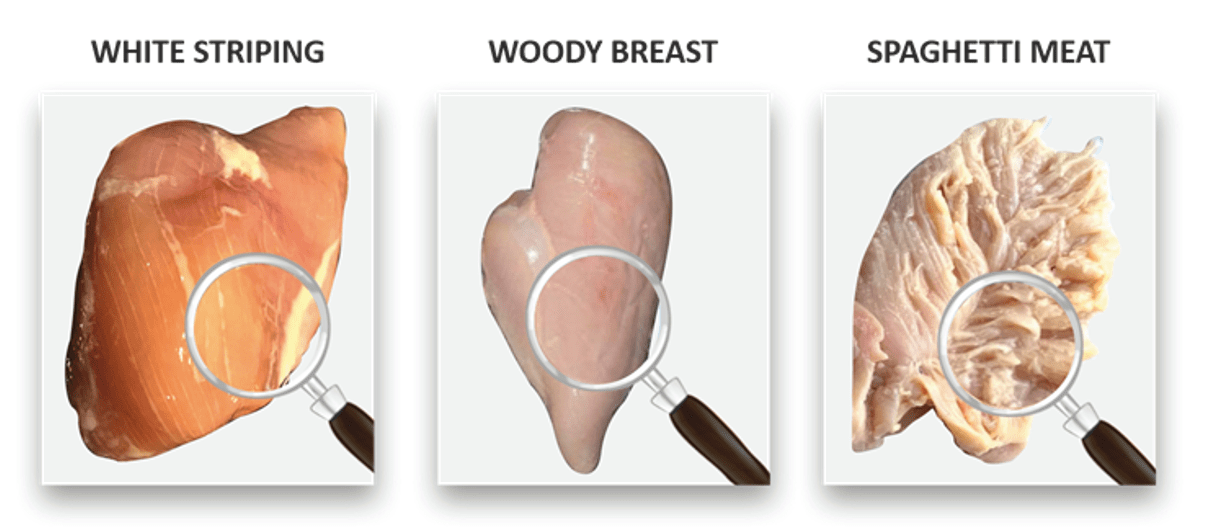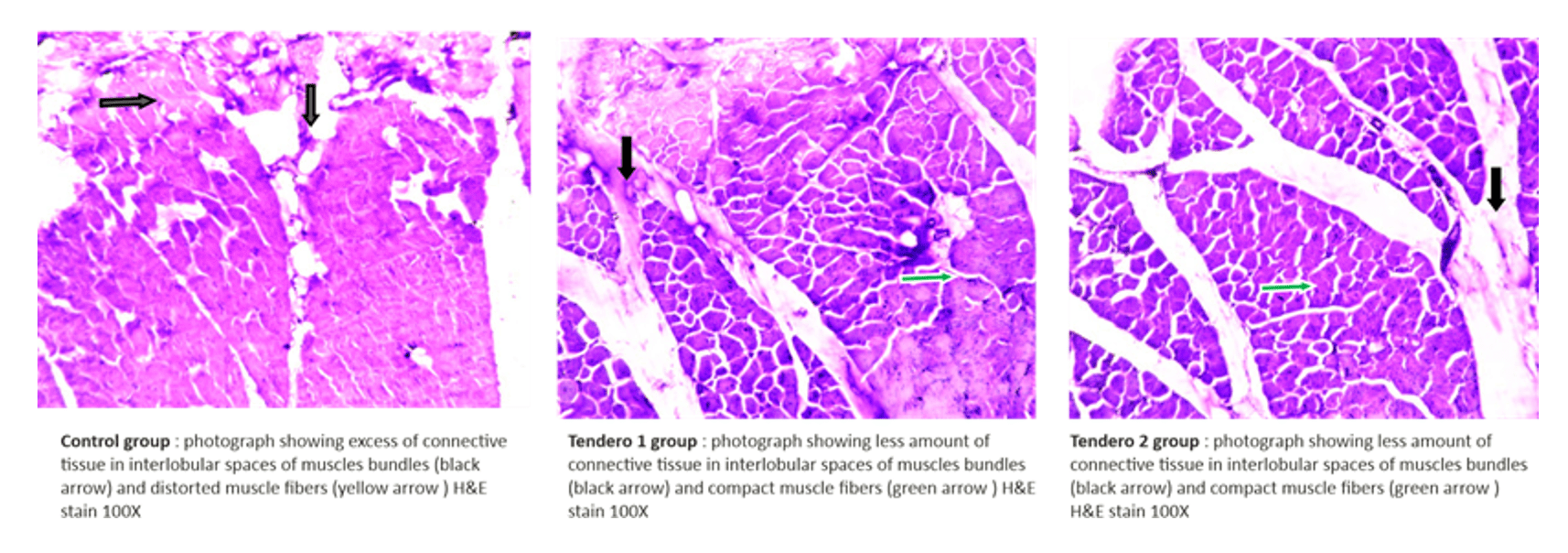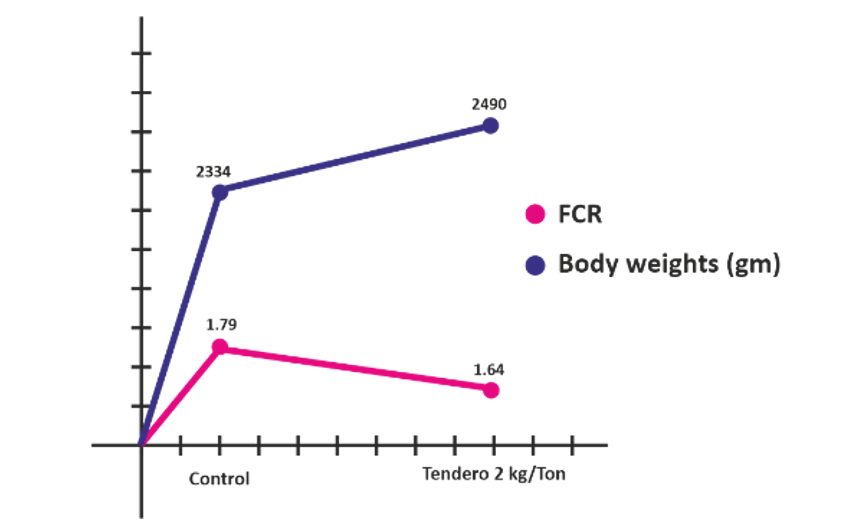



Woody breast myopathy and white striping
Undesirable textural changes in chicken in the modern poultry industryWoody breast (WB), or "Spaghetti meat" affects modern, rapidly growing, high breast yield broilers. Decreased meat quality due to undesirable change in muscle texture and condemnation of affected breast meat cause huge economic losses. WB incidence has increased steeply from 5% in 2012 to 29% in 2015 and has been reported to affect up to 50% of the flocks (Abasht et al., 2016). The majority of cases have been reported in the EU, USA, Canada, Australia, New Zealand, Japan and Brazil.
To enquire about Tendero contact Vinayak Ingredients

Woody breast myopathy is significantly impacting modern poultry lines of broilers imposing economic burden on the poultry industry worldwide due to on-farm culling and mortality, down-grading and condemnation at processing (Chatterjee et al., 2016). People at the processing plants are getting better at identifying the condition and reporting it before it gets to restaurants who would complain having been disappointed with the quality of their purchase. The affected meat tastes woody and stringy, some experts describe the texture as being "gummy".
The heavier the bird, and the larger the quantity of meat on it, the more likely it is to develop woody breast. While the condition can be found in leg meat, it typically affects breast meat, with enough impact to disrupt the supply chain. The occurrence if these unwanted myopathies has been associated with increased growth rate in modern birds. In the laboratory, the condition can be detected in chicks as young as a week old.
Etiology and microscopic changes in the meat
It was noted that only ten percent of breast meat has woody breast, but it can be detected by looking for pale meat with bulging areas. White stripes on the meat are also indicative of texture and taste defects in the meat. Also, chickens weighing more than nine pounds seem to be more likely to have woody breast syndrome.
Intensive breeding in broilers to strengthen the genetic markers for large breast meat, and this is thought to be a factor in the development of woody breast in recent years. The reported changes are: oxidation of proteins in muscles, muscle-fibre degeneration (Myopathy) and an increased deposition of connective tissue and fat microscopically. In addition, it has been noted that birds with woody breast have a decreased water-holding capacity, and are slightly larger on the growth curve than other birds.

Moreover, feeding birds with high energy and protein diets, age, gender, genetics, and stress had been associated with the woody breast myopathy (Kuttappan et al., 2016).
Various identifying methods to detect woody meat
The US has brought Certified Quality Reader (CQR), is a first ever, non-invasive, handheld device that instantaneously detects and measures woody breast in broiler fillets based on electrical impedance analysis (BIA) to detect woody breast a muscle myopathy. Also at large processing plants it might be possible to X-ray the meat or use electrical impedance measurement and different applications of imaging technology.
There have been several approaches to minimize muscle myopathies in chicken to improve meat quality like supplementing amino acids, phytase, vitamins, mineral and other feed additives or changes in the farm management regime, however we could not find a promising solution to this condition yet.
Our research team have developed a phytogenic combination which works on preventing muscle myopathies, improving nutritive value and carcass quality of chicken.
TENDERO, an amino acid optimizer keeps the muscles tender and free from unpleasant textural changes like woody breast, white stripping and spaghetti meat.
To enquire about Tendero contact Vinayak Ingredients

he metabolomics and proteomic studies shows that hypoxia and activation of its upstream mediators play a key role in the muscle myopathies. Piperines, Flavonoids and Polyphenols derived from Allum sp. and Piper nigrum, are potent antioxidants and anti-inflammatory components. They prevent fibrosis, immune cell infiltration and muscle fibre degeneration and assist in its repair which regulates the bio-physiology of the muscles.
Tendero modulates muscle oxygenation and nucleotide pathways, and molecular signaling which alters affected bio-functions in the muscles and prevents myopathies in the modern lines fast growing broilers.
The actives of Tendero prevent the oxidative stress within the breast muscles through free radical scavenging, cell signaling and maintaining lipid, carbohydrate, amino acid and nucleic acid metabolism.
Meat quality is an important measure of meat palatability and acceptability to consumers. The in-vivo experiments in broiler chicken improved the chicken quality factors like water holding capacity, juiciness, tenderness, meat texture and margination uptake.
TENDERO is a research proven herbal supplement for the immerging issue of muscle myopathy and to improve organoleptic characteristics. It is leading in the broiler industry for its benefits like improved carcass traits, higher nutritive value, improved textural and meat processing features.

It is recommended to use in broiler finisher feeds @ 2 kg per MT of feed to achieve tender and soft chicken, minimize cooking loses, and higher margination uptake with no withdrawal period.
To enquire about Tendero contact Vinayak Ingredients










